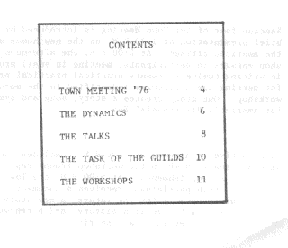

|
PRELUDE
The first of the day's five sessions, begins at 9:00
A.M. with coffee and doughnuts, as the participants register,
visit together and gather for the welcoming address.
CHALLENGES
A brief presentation on the new world of the Bicentennial
Era introduces Session Two the morning workshop at 10:00 A.M.
In the workshop the participants meet in small groups, identify
the economic, political and cultural issues and analyze the foundational
challenges to our nation as we enter the Bicentennial Era.
INTERLUDE
Session three of the Town Meeting is a festive noontime
interlude. As the participants enjoy an informal lunch at 12:30
P.M., special guests and community leaders are received, and an
array of local entertainment and group singing creates a powerful
happening.
PROPOSALS
Session four of the Town Meeting is introduced by
a brief presentation at 1:30 P.M. on the new human and the American
citizen. At 2:00 P.M. the afternoon work shop engages in participants,
meeting in small groups, in writing twelve to twenty practical
practical proposals for meeting the challenges indentified in
the morning workshop. One group creates a story, song and symbol
for America's Bicentennial Era.
PLENARY
Session five, beginning at 4:00 P.M. concludes the day with a plenary in which the workshop groups report on the day's accomplishments. At 5:00 P.M. the Town Meeting adjourns. Each participant receives a document holding the group's proposals for the future, a new story of the community's role in American history, and a renewed sense of the American revolutionary spirit.
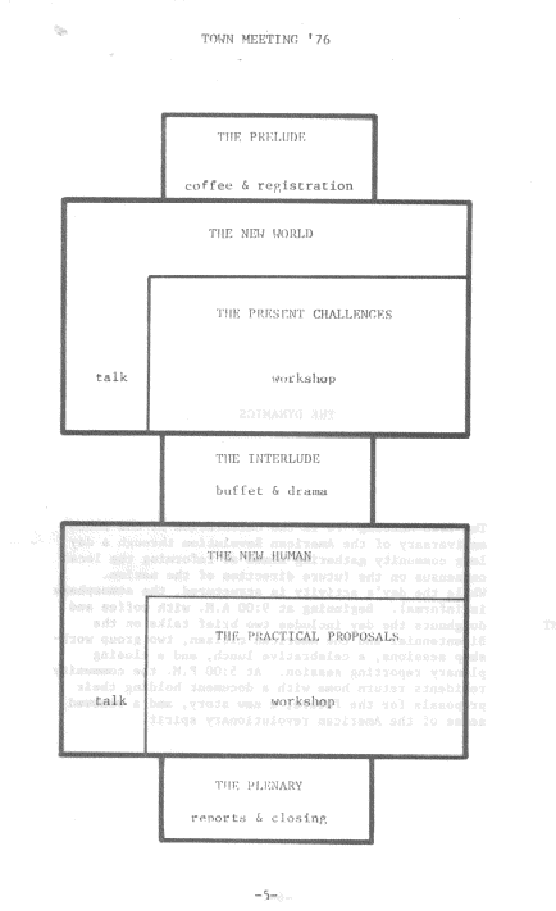 |
THE EVENT
The Town Meeting '76 is the celebration of the 200th
anniversary of the American Revolution through a day long community
gathering aimed at reforming the local consensus on the future
direction of the nation. While the day's activity is structured,
the atmosphere is informal. Beginning at 9:00 A.M. with coffee
and doughnuts the day includes two brief talks on the Bicentennial
and the American citizen, two group workshop sessions, a celebrative
lunch, and a closing plenary reporting session. At 5:00 P.M. the
community residents return home with a document holding their
proposals for the future, a new story, and a renewed sense of
the American revolutionary spirit.
THE TALKS
A key dimension of the drama of the Town Meeting
is the two brief contextual talks set at the beginning of the
morning and the afternoon sessions. The first, on the new world
of the Bicentennial Era, articulates the new situation we find
ourselves in as we enter the next 200 years. The second on the
new human and the American citizen, delineates the issues, responsibilities
and possibilities given to us as citizens in this new era.
THE WORKSHOPS
The workshops are the highlights of the Town Meeting.
In two sessions of two hours each, the gathered representatives
of the community work in four groups, first to discern the underlying
challenges facing our nation, and secondly to create practical
proposals and a story to give direction to our nation as it enters
the Bicentennial Era.
THE PLENARIES
The Town Meeting begins and ends as a celebrative
gathering of the community in a plenary session. Opening is informal
with coffee and rolls, informal conversation, and visiting. This
is followed by community singing, a conversation, and a talk.
The closing plenary centers around group reports and a
presentation of the work of the day. It is cast in a highly celebrative
mood and marks the dramatic close of the day.
THE INTERLUDE
Punctuating the Town Meeting at its center is the lunch time interlude. Around a sumptuous buffet lunch,
coordinated array of local entertainers (professional and amateur, planned, and spontaneous) provides dis-
continuous celebration time for the community. Dancing,
music, comedy, and community singing blend into a powerful happening
in the middle of the day.
I. THE PROFOUND TIMES
A. The Transitional Era
B. The Dynamic Sociality
C. The Unexpected Vista
D. The Global Phenomenon
II. THE NEW SETTLEMENT
A. The Emerging Community
B. The Postmodern Wilderness
C. The Social Pioneers
D. The Reconstructed Earth
III. THE GREAT RESURGENCE
A. The Nation's Rebirth
B. The Practical Vision
C. The Grassroots Awakenment
D. The Local Initiative
IV. THE TOWN MEETING
A. The Historical Reality
B. The Human Dynamic
C. The Interdependence Declaration
D. The Singular Happening
The First Talk establishes a rapport among the Town
Meeting participants as they grasp the new social situation emerging
in this Bicentennial Era. It demonstrates the presence of this
new sociological situation in our everyday lives in local situations
as well as pointing to the broad shifts occurring across the globe.
Further, it articulates the resurgent posture emerging in people
today relative to living in this new world, and affirms the appropriateness
of the Bicentennial Era as an opportunity and the Town Meeting
as a vehicle for responding to this new world.
THE TALKS
THE NEW HUMAN
I. THE HUMAN CRISIS
A. The Awefilled Challenges
B. The Endless Engagement
C. The Vocational Collapse
D. The Meaninglessness Malaise
II. THE NEW SPIRIT
A. The Emerging Human
B. The Lifegiving Engagement
C. The Indicative Care
D. The Human Fulfillment
III. THE FOUNDATIONAL REBIRTH
A. The Infinite Relatedness
B. The MaleFemale Dynamic
C. The Four Lifetimes
D. The New Rationality
IV. THE GLOBAL CITIZEN
A. The Effective Citizen
B. The Tactical Citizen
C. The Corporate Citizen
D. The Motivated Citizen
The Second talk engages people in reflecting on the
new kind of human being emerging in our world today. It describes
the sense of crisis in us all as a sociological rather than psychological
reality. It demonstrates that in the heat of engagement in this
complex new world of ours a rebirth of human spirit or drive is
occurring that is causing us to recover in a profound way the
basics of human life. Finally, the lecture probes the practical
style of this new human for the next 200 years.
_9_
THE TASKS OF THE GUILDS
The Town Meeting will operate as a single group divided
into four guilds. The total group will gather to open ant to close.
Lunch will al lo be as a total body. The workshops will be done
in the four guilds. In the morning each of the four guilds will
work to discern the social challenges facing the nation. In the
afternoon Guild A will take the economic challenges from the morning
and create a set of proposals for them. Guild B will do the same
for the political challenges and Guild C for the cultural. Guild
D will create a story, song, slogan and symbol for the Bicentennial
Era.
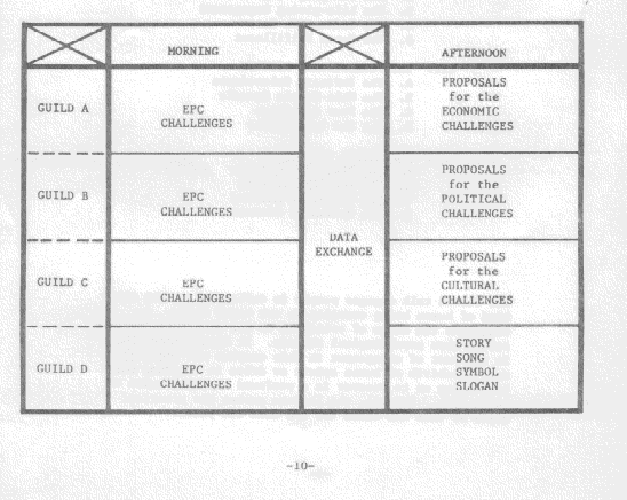 |

Session I aims to release local citizens to participate authentically, in shaping the American destiny by objectifying their intuitions about society and allowing them to state the sociological challenges which face the nation. | The practical task of this workshop session is to organize the complex issues of our time and name them as the economic, political and cultural challenges facing the nation. |
INTRODUCTION: Reflect on what'a going on in society today.
CONCLUS ION: Reflect
on the actions the challenges suggest.
WHERE IS SESSION I - THE CHALLENGES
PAGE 11 IN THE DOCUMENT GOES HERE
THE WORKSHOPS:
SESSION II THE PROPOSALS
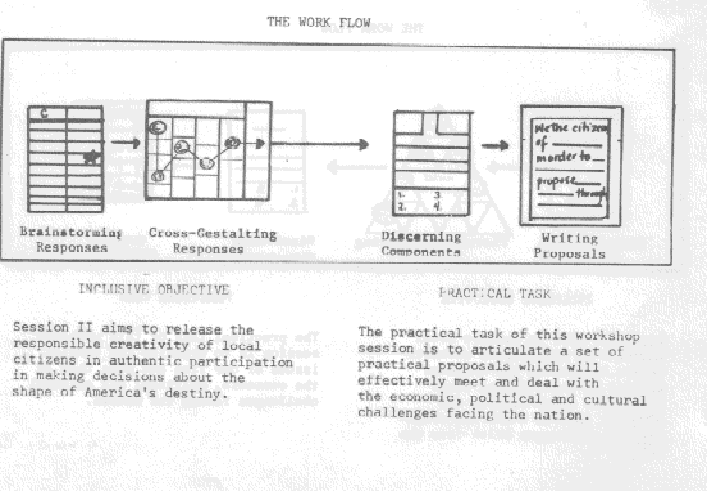 |
THE PROCEDURAL OUTLINE
INTRODUCTION: Reflect on how the people are responding
to these challenges.
1. Brainstorm appropriate social responses to the
challenges.
2. List key responses to each challenge and organize
all the responses into 4 or 5 proposal arenas.
3. State the primary aim, proposed activities, and
potential tactics necessary in each arena.
4. Create succinct practical social proposals for
each arena.
CONCLUSION: Discuss briefly the inclusive and local
implications of your work.
|
|
INCLUSIVE OBJECTIVE PRACTICAL TASK
The story workshop aims to release The practical task of the workshop
local citizens to experience the session is to create a story, song,
story of this nation as a great slogan and symbol that recaptures
story and one that needs to be the significance of the past and
retold for our time. sets the course into the future.
INTRODUCTION: Reflect on the role of stories in the
life of great cultures.
1. Brainstorm story components and set a group aside
create a new story for the nation.
2. Brainstorm song components and set a group aside
to create a new song for the nation.
3. Create a new slogan and a symbol for the nation.
CONCLUSION: Reflect on the significance of the workshop and send the group to the Plenary.
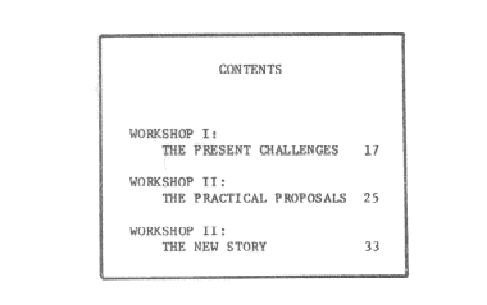 |
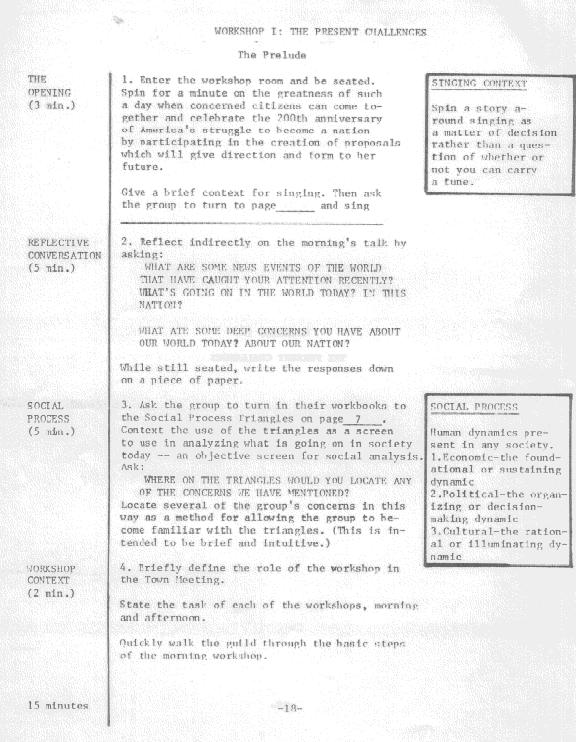 |
| LIST
CLUSTER ISSUES (2 min.) | 13. The intent of this movement is to lead participants in creating individually the basic data for work in groups during Movement IV. Begin by counting off by the number of clusters. Assign all l's to cluster #l, etc. Have individuals relist the challenge arena name and the accompanying issues in their cluster on p. 18 of their workbooks. | |
WRITE SITUATION PHRASE
(2min.) STATE UYDERLYING CHALLENGE
(3 min.) | 14. Ask the group to individually write a phrase which describes the social situation implied in their assigned cluster of issues. As1o:
IN WHAT ARENA OF SOCIETY DOES THIS CLUSTER OF ISSUES APPEAR? Have one or two persons give their challenge arena name and social situation phrase 15. Ask the group to individually write a phrase that states the present challenge or social necessity facing the nation that is underlying their cluster of issues. Ask: WHAT ARE THE CHALLENGES PRESENTED TO THIS NATION BY THE PARTICULAR ISSUES WITHIN THE CLUSTER ? List. WHAT IS THE ONE UNDERLYING CHALLENGE? | 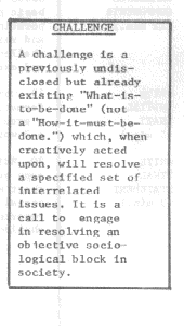
. |
LIST LOCAL MANIFESTATIONS
(3 min) | 16. Ask the group to individually write three manifestations of their challenge as it is present in their local community. Ask: WHAT ARE THREE LOCAL MANIFESTATIONS OF YOUR CHALLENGE IN TTIIS COMMUNITY? |
l0 minutes
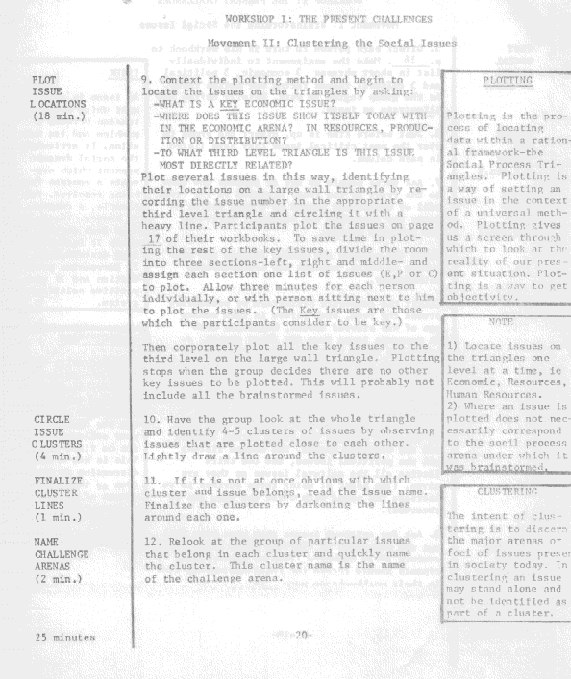 |
PAGE 21 Movement III DiscerNG THE CHALLENGE COMPONENTS
 |
THE 21. Regather as a guild. Tape challenges or GATHERING sentences to the wall in the front of the room. (3 min.) Ask a scribe to copy these challenge titles sentences with the social process arenas indicated on paper and label with the guild's letter. Take this to production at lunchtime to be typed during the afternoon workshop. Sing a song #_____________
Spin a hit on the plenary and its role in the construct of the day. CHALLENGE 22. Call for reports from each group. Have the REPORTING reporter read the challenge title, social process arena and sentence.
(5 min.) Individuals may record all the guild's challenges in their workbooks on page 19 . Ask for questions of clarity. CORPORATE 23. Reflect on the work of the morning: REFLECT10N -WHAT CHALLENGES STRIKE YOU ? (5 min.) WHICH ARE MOST CRITICALLY DEMANDNG OF OUR ATTENTION? WHICH CHALLENGES ALREADY SUGGEST TO YOU CONCRETE ACTIONS OR WAYS OF MEETING THEM? WHICH CHALLENGE IS SOCIETY ALREADY MOVING
ON? READY TO MOVE ON? Reflect on the dynamic of corporateness: WHAT DID WE DO THIS MORNING?
WHAT DID YOU LEARN ABOUT WORKING IN A GROUP? THE 24. Announce the luncheon interlude
CONCLUSION to follow immediately. Mention that the afternoon session will begin with a talk at 1:30.
Send the guild out to lunch after singing 15 minutes | 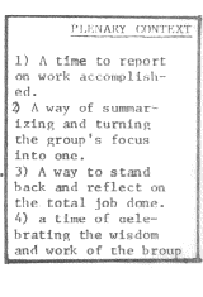
|
WORKSHOP II: THE PRACTICAL PRO9
The Prelude
THE OPENING (2 min.)
1. Gather as a guild. Spin on the recovery of authentic
celebration in the life of a people, i.e. the Bicentennial
celebration and the participation of Americans in forgin the next
200 years by articulating the challenges and creating the practical
proposals for meeting them a new form of celebration recovering
the past and planning for the future.
GUILD SINGING (4 min)
2. Spin a short context on singing and sing # . (Ask
the group for a suggestion of a second song.)
REFLECTIVE CONVERSATION (2 min.)
3. Reflect for a moment on how people are responding
to the world situation by asking the group these questions:
WHAT KIND OF RESPONSES DO YOU REAR OR
SEE PEOPLE TAKING TO THE ISSUES THAT
WE ARTICULATED THIS MORNING?
WHERE DO YOU SEE THEH RESPONDING WITH
"I DONT CARE"?
WHERE DO YOU SEE PEOPLE DEEPLY CARING?
WORKSHOP CONTEXT (2 min.)
4. Briefly review the place of this session in the
flow of the day and talk through the task and steps of this particular
workshop.
10 minutes
RECORD 5. Context this step as using the method of CHALLENGE brainstorming to get out as many ways as TITLES possible of practically and effectively meeting (2 min.) the challenges which have been named. Have the group record the challenge titles in the guild's
arena (EPC) on page 28 of their workbooks. READ 6. Review the challenges by reading aloud both CHALLENGE the challenge titles and accompanying sentences. STATEMENTS
(2 min.) LIST 7. Have the guild individually list one SOCIAL practical social response for each challenge on RESPONSES page 28 of their workbook.
(3 min.) SELECT 8. Have the guild individually star their key KEY response. RESPONSES (3 min.) | 
|
RECORD 9. Have a scribe come to the front of the room and GROUP record individuals' starred responses on wall sheets, RESPONSES one for each challenge. Corporately get up a list by (12 min.) asking individuals to call out their starred responses
for the first challenge. COMPLETE 10. Ask for other critical responses which have been CROSS omitted. Complete the chart on page 29 so that GESTALT there are a total of 1625 responses. CHART
(3 min.) CREATL 11. Context the crossgestalting method and begin. RESPONSE SETS (10 min.) A. Marking key responses, look across the lists of responses as a group and mark one key response with a symbol such as *,#, etc. B. Mark related responses. Discern other responses which relate to the marked key response and give same symbol. C. Relate other responses. Select another key response and mark those related to it with a common symbol. D. Include all responses. Continue Step C until all responses are marked, checking that there are only 4 to 5 symbols used.
Do this both on wall chart and workbook page29. NAME 12. Draw lines connecting similarly marked responses. PROPOSAL Review the responses within each of these proposal ARENAS arenas and give each arena a 35 word title. Relist
( 5 min.) the responses under the appropriate arena title. 30 minutes _ | 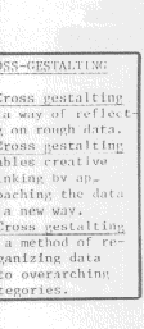
|
LIST 13. The intent of this step is to lead the ARENAS participants in individually creating the RESPONSES basic data for work in groups during move- (2 min.) ment #4. Begin by counting off by numbers of proposal arenas. Assign all #1s to pro- posal #1, #2s to proposal #2 and so on. Re-list the responses under the appropriate crossgestalt arena title on the wall chart
and on page It 30 of workbook. WRITE 14. Have the group state individually in INTENT 35 words the one primary intent or aim of PHRASE the data listed within their proposal arena. (2 min.) Ask one or two people to read their arens
and phrase. STATE 15. Individually state, in 35 words, the PRACTICAL one practical social activity which is called ACTIVITY for within this proposal arena.
(3 min.) LIST 16. Individually list, in 35 words, several LOCAL tactics which this community could do to begin IMPLEMENTATIONS to implement the proposal. (3 min.) | 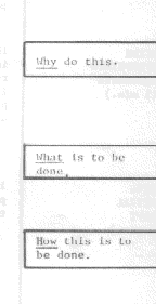
|
COLLECT 17. Context this movement as doing tile final GROUP pulling together, writing and refinin,: of the DATA proposals which will effectively meet and deal (5 min.) with the challenges confronting our n.rtion. Each group will write one proposal for its arena. Talk through the procedures as found on page # 3() of the workbook. Assign ~,rouns t~ to meeting spaces and indicate time allotment of 20 minutes. Move to groups. Read aloud and record all individual statements of the proposal elements, intent, local tactics, and
practical activity. DECIDE 18. Select the best statement of primary APPROPRIATE intent, incorporating the p,roup's data and COMPONENTS refining as needed. Do the same for the (15 min.) intent and local tactics, determining, the practical activity and the 4 most exciting
and practical tactics. WRITE 19. Using the prescribed format, write the INITIAL proposal statement. As a group, give the DRAFT total proposal a 3word title.
(5 min.) POLISH 20. Edit and refine the proposal statement FINAL and copy both the title and statement on a STATEMENT wall chart for the Ouild Plenary. Assip,n
(5 min.) a reporter | 
|
THE 21. As the guild gathers, post proposals in
GATHERING the front of the room. Assign a scribe to
(3 min.) copy down all the proposal titles and sentences. Send to Production immediately
for typing.
Sing an appropriate song. _____________#_____.
PROPOSAL 22. Call for reports from each of the groups.
REPORTING Reporters should read their proposal titles
(5 min.) and sentences.
At the conclusion of all reports affirm the wisdom
and work of the groups.
CORPORATE 23. Corporately reflect on the work of the
REFLECTION guild:
(5 min.)
"WHAT DID YOU NOTICE ABOUT THESE PROPOSALS?"
"WHAT CAUGHT YOUR ATTENTION?"
"WHAT DO YOU SEE AS THE IMPLICATIONS FOR THE
NATION OF IMPLEMENTING THESE PROPOSALS FOR
THE GLOBE?"
"WHAT WOULD BE THE PRACTICAL EFFECT OF DOING
THE LOCAL IMPLEMENTATIONS IN YOUR COMMUNITY?"
Briefly reflect an the dynamics of corporateness
operating today:
"WHAT DID YOU LEARN TODAY ABOUT THE PROCESS
OF DECISIONMAKING?"
THE 4. Assign a reporter for the closing, plenary
CONCLUSION and announce the move immediately to the plenary.
(2 min.)
Close by singing ____________________#____
THE 1. Gather as a guild. Spin on the recovery of celebration
OPENING in the life of a people i.e., the Bicentennial celebration
(5 min.) as a time when Americans can recall the time of the creation
of the country and participate in creating the vision of the
next 200 years. Celebration takes on real significance when
it is in the midst of a people's sense of the challenges
con
Sing __________________ on page ______.
STORY 2. Begin by reading a story. (excerpt from John Brown's
READING Body.) Briefly reflect on the reading:
(5 MIN.)
"WHAT WERE THESE PEOLE (THE ONES FROM WHOM THIS STORY
HAD ITS SOURCE) SAYING ABOUT THEIR ORIGIN?" (PAST)
"WHAT WERE THEY SAING ABOUT THEIR DESTINY?" (FUTURE)
WHAT WAS BEING SAID ABOUT THEIR STUGGLE OVER-AGAINST
THEIR PAST AND FUTURE?" (PRESENT)
WORKSHOP 3. Review the place of this workshop in the day's time design.
CONTEXT
(2 min.)
BRIEF 4. Spin about the latent creativity in all of us. EACH OF
SPIN US, I SUSPECT, HAS AT LEAST THREE GREAT ARTISTS LURKING IN-
(3 min.) SIDE US. EACH OF US IS A STORYTELLER, EACH A MUSICIAN, AND EACH AN ARTIST. (GROUND IN THINGS LIKE WHISTLING OR HUMMING, DOODLING, TRYING TO WRITE A LOVE LETER AND SO FORTH. SOMETIMES THAT GETS STIFLED BY TEACHERS, AND OTHERS, BUT IT'S THERE. WE'RE GOING TO EXPERIMENT WITH RECOVERING THAT, BUT AS A PEOPLE RATHER THAN AS INDIVIDUALS. OUR TASK, IN THIS AFTERNOON'S SESSION, IS TO WRITE A STORY AND A SONG AND CREATE A SYMBOL AND SLOGAN WHICH HOLD IN GREAT ARTISTIC FORM OUR TIMES, OUR HERITAGE AND OUR FUTURE. WE'LL CREATE A GREAT STORY OF A GREAT PEOPLE, A GREAT SONG OF A GREAT PEOPLE, A GREAT SYMBOL AND SLOGAN OF A GREAT PEOPLE.
ANY QUESTIONS? LET'S SING ONE MORE SONG BEFORE WE START.
LETS SING ______ ON PAGE ______.
14 MINUTES
CREATE 5. Ask the guild to turn to page 39 in their
STORY workbook and individually list 23 images that hold our
ELEMENTS wisdom about America in each of the three categories,
(20 min.) past, present, future.
Past WHAT ARE SOME IMAGES THAT SPEAK OF WHERE
WE ARE AS A NATION? COME FROM?
Present WHAT IMAGES HOLD THE CHALLENGES CONFRONTING
US TODAY?
Future WHAT PRASES POINT US TOWARD THE FUTURE?
WHAT PHRASES SPEAK OF WHERE WE, AS A NATION, ARE GOING?
Ask three scribes (again to save time) to come
to the front and record individually listed items by calling for
past, present, and future images consecutively. Get as many images
(10 or more) in each category as possible.
Ask for any additional images that need to
be included
Ask for someone to suggest a master image which
roughly holds the data in each category. Record on a wall chart
and workbook page 39 .
6. Now count off by threes and by spinning a hrief
context outlining the task, prepare to send off 1/3 of the guild,
the ones, to write the story. Context this storywriting
group as having the task of creating a three paragraph story which
powerfully and imaginally retells the journey of this nation and
its people in terms of their heginnings, present challenges and
destiny.
Send out the story group, telling them they will
have 50 minutes to complete their work.
20 minutes
WRITE DRAFT PARAGRAPH (15 min.)
6. cont. Gather in new space and rearticulate the
task.
Divide into 3 6ubgroups. One subgroup will write a paragraph which pulls together and holds the guild's
wisdom and images on the past. Another will do the
same for the present and the third subgroup will write a
paragraph on the future.
Begin by having each person in the subgroup write a holding sentence on their category.
Read these aloud, and record on a wall chart in your subgroup. Then corporately reflect on them hy asking: What struck you? What phrases did you hear that seemed Just right? Which sentence seemed best to hold the wisdom of the guild's brainstorm? Decide on or create together one sentence as your central or topic sentence for the paragraph.
Feed in parts of other sentences and corporate
insights, working together to create a paragraph which powerfully
holds the past/present/future of this nation.
CRITIQUE DRAFT PARAGRAPH (20 Min.)
7. Gather as a total group to revise draft paragraphs.
Read the three rough paragraphs.
Reflect and take notes.
What is needed so that one story is created? Suggest ways of unifying the whole story.
Decide on a title for the whole story.
POLISH NEW STORY (15 min.)
8. Return to the subgroups
Note reflections and suggestions.
-Corporately refine each sentence.
Read aloud for flow and meaning. Write and polish form.
Copy onto wall chart for presentation to the guild.
Assign someone to read the story to the guild or
have a choral reading.
50 minutes
WORKSHOP: THE NEW STORY
WRITE DRAFT VERSES (10 min.)
10. Outline the procedure:
Divide into groups one for each verse
and one for each chorus.
Each member of the group writes a verse to
the selected tune or its part, using the allocated qualities.
Attention should be given to rhyming and the correspondence of
syllables to notes and musical phrases to lines of verse.
As a subgroup, read and sing individual
verses. Reflect:
WHAT PHRASES CAUGHT HOLD OF YOU? WHICH ONE SEEMS
TO BEST HOLD OUR WISDOM AND EMBODY THE SPIRIT OF THE AMF RICAN
PEOPLE? Select one verse to use as a basis.
Using images, rhymes and phrases from the individual
drafts, create a group verse.
CRITIQUE DRAFT VERSES (8 min
11. Begin now the critique of the draft verses.
Gather as a group and sing the verses in order.
Suggest and note refinements for the individual verses.
Make suggestions for improving the whole by checking for flow from verse to verse and unity of the entire song.
Give the song a name.
POLISH NEW SONG (7 min.)
12. This is the time for doing the final production
of the song.
Return to subgroups.
Refine each line and phrase of the verse.
Sing the verse, checking for rhyme and meaning.
Copy the verse on a wall chart, making sure to note the
title and tune of the song.
As a group assign someone to introduce the song to the guild.
Send someone to production with a clearly written
copy of the song, its title and tune. Send out the song group,
tellIng them they wil1 have 2S minutes to complete their task.
25 minutes
WORKSHOP THE NEW STORY
Movement III: Designing the New Symbol
CREATE SYMBOL ELEMENTS (10 min.)
13. With the remaining 1/3 of the guild, begin the
creation of a slogan and symbol.
Rather quickly create a slogan which will capture
the spirit of the times and motivate this community and nation
toward building the future. Have people individually write a slogan
in their workbooks on page 40. Then have individuals call their
slogans out. Write them on a wall chart. Corporately star individual
choices of the best slogan from the group's list. Try them out
as a group Imagine various situations in which the slogan might
be used and places where it might be written. Decide on the one
slogan.
Begin the creation of a symbol. Spin on the
task as the creation of a fine art form of the times in which
we live one which will, perhaps, be a permanent symbol
of the American people and this community. Brainstorm possible
components of the symbol, as implied by the slogan. Ask:
WHAT WOULD BE THE ELEMENTS OF A SYMBOL WE WOULD CREATE?
Brainstorm other symbol components implied in the themes decided for the song and the images used in the story.
As a group select and mark the key components.
DRAW INITIAL SKETCH (5 min.)
14. Begin the preliminary drawings of the symbol.
Have each individual sketch several symbols.
Suggest that they check each one for inclusiveness, clarity and power.
Ask them to select their best.
Have each draw his best symbol on a wall chart
for the group to see.
CRITIQUE 15. Begin to evaluate and reflect upon the sketches.
INITIAL
SKETCH As a group, reflect on the individual symbols:
(5 min.) WHICH ONES STRIKE YOU?
Have several tell a story about a symbol other than
their own.
WHAT DOES IT SYMBOLIZE FOR YOU?
IF YOU SAW SOMEONE WEARING THIS ON HIS LAPEL, WHAT WOULD IT TELL YOU ABOUT THAT PERSON?
WHICH ONE SEEMS TO BE MOST IN THE DIRECTION OF WHAT
IS NEEDED?
Select one of the individual symbols to be
the basis for polishing.
Make suggestions for feeding in insights and
images from the other symbols.
Revise the slogan at this point, if that seems
necessary upon reflection and work on the symbol.
REDRAW 16. Move now to the final drawing of the symbol.
NEW
SYMBOL Decide the color scheme for the symbol.
(5 min.)
Redraw the symbol on a wall chart. Assign someone to
present the symbol and slogan to the guild.
Ask several people to spin the story this symbol
tells.
Have the group name practical uses for the
symbol
25 minutes
WORKSHOP: THE NEW STORY
Movement IV: Producing the New Story
NAME NEW DRAMA (5 min.)
17. This movement needs to be orchestrated so as to allow The group's creativity to emerge and focus into A fine dramatic presentation for the final Town Meeting Plenary. The key is not to be found in mechanically following procedures, but in allowing the guild to focus its time and effort on whatever steps seem most helping.
Regather as a total guild and sing on page
________.
Call for presentation of:
1) Symbol and slogan
2) Song
3) Story
Reflect briefly on each at the completion of the third report.
WHAT WAS THE STRIKING OR SURPRISING GIFT OF EACH?
WHAT IMAGE? SYMBOLS SPOKE MOST POWERFULLY?
WHAT STORY WOULD YOU TELL THAT HOLDS ALL THESE TOGETHER?
Individually write an imaginative title for the drama.
Share the individual work and decide on the
final title for the drama.
DESIGN NEW DRAMA (5 min.)
18. As a guild design the new drama.
Arrange the components of the symbol and slogan and the song and story into acts.
Share individual arrangements, discuss and decide the final acts, name each act.
Invent an imaginal way of getting on and off stage.
Build an imaginal chart of the drama.
STAGE NEW DRAMA (5 min.)
19. Stage the new drama
Assign all the guild participants to roles in the drama.
resign the practical movement of people around the staging area.
Create any appropriate costumes.
Build any necessary props or scenery.
REHEARSE NEW
20. Rehearse the drama.
-Perform the entire drama
-Rehearse again any parts or the total drama as necessary.
-Make any final change.
-Do a dress rehearsal.
20 minutes
THE 21. Move now into reflection by singing,
OPENING on #
(1 min.)
DRAMA 22. Check to see that everyone is ready for the presentation.
CHECK
(1 min.)
CORPORATE 23. Reflect on the work of the session.
REFLECTION HOW WOULD YOU TALK ABOUT WHAT WR HAVE DONE?
(2 min.) WHAT IS THE FUNCTION IN SOCIETY OF THIS SORT OF F.XF.RCISE?
WHAT IS THE SIGNIFICANCE OF IT? (WHY DO IT AT ALL?)
WHAT HAS HAPPENED TO THIS GROUP AS A RESULT OF DOING
THIS EXERCISE?
THE 24. Sing on #
CONCLUSION Dismiss to the closing plenary, making sure everyone is ready
(1 min.) for the drama. Check to be sure the story, song, symbol and
slogan have all been turned into production.
5 minutes